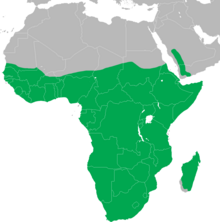Hamerkop
| Hamerkop | |
|---|---|
 |
|
| At iSimangaliso Wetland Park, KwaZulu Natal, South Africa | |
| Scientific classification | |
| Kingdom: | Animalia |
| Phylum: | Chordata |
| Class: | Aves |
| Order: | Pelecaniformes |
| Family: |
Scopidae Bonaparte, 1849 |
| Genus: |
Scopus Brisson, 1760 |
| Species: | S. umbretta |
| Binomial name | |
|
Scopus umbretta Gmelin, 1789 |
|
 |
|
| Range of the hamerkop | |
The hamerkop (Scopus umbretta), also known as hammerkop, hammerkopf, hammerhead, hammerhead stork, umbrette, umber bird, tufted umber, or anvilhead, is a medium-sized wading bird 56 centimetres (22 in) in length with a weight of 470 grams (17 oz). The shape of its head with a long bill and crest at the back is reminiscent of a hammer, hence its name. It ranges from Africa, Madagascar to Arabia, in wetlands of a wide variety, including estuaries, lakesides, fish ponds, riverbanks and rocky coasts in Tanzania. The hamerkop, which is a sedentary bird that often show local movements, is not globally threatened and is locally abundant in Africa and Madagascar.
The hamerkop is usually included in the Ciconiiformes, but might be closer to the Pelecaniformes. It constitutes a family (Scopidae) and genus (Scopus) all on its own because of its unique characteristics.
There are two subspecies, Scopus umbretta umbretta and Scopus umbreta minor.
Its plumage is a drab brown with purple iridescence on the back (the subspecies S. u. minor is darker). The bill is long, flat, and slightly hooked. The neck and legs are shorter than those of most of the Ciconiiformes. The hamerkop has, for unknown reasons, partially webbed feet. The middle toe is comb-like (pectinated) like a heron's. Its tail is short and its wings are big, wide, and round-tipped; it soars well. When it does so, it stretches its neck forward like a stork or ibis, but when it flaps, it coils its neck back something like a heron.
Vocalisations include cackles and a shrill call given in flight. Hamerkops are mostly silent except when in groups.
...
Wikipedia

